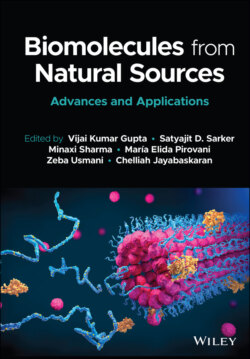Читать книгу Biomolecules from Natural Sources - Группа авторов - Страница 30
1.9 Biologic Activity
ОглавлениеAs mentioned before glycolipids have a wide range of applications. Since trehalose lipids are able to reduce the surface tension of aqueous solutions and the interfacial tension between aqueous and oil phases and have low CMCs, they are especially used as emulsifiers, foaming, wetting (Mujumdar et al. 2019), solubilizers anti-adhesive and antimicrobial agents, among others.
Therefore, trehalose lipids show great potential in different fields (Kuyukina et al. 2001; Mutalik et al. 2008). They are able to act in diverse industries, including (i) the environmental industry with applications such as microbial-enhanced oil recovery, biodegradation of polycyclic aromatic hydrocarbons or oil-spill treatment, (ii) the food industry, where trehalose lipids are especially used as emulsifiers, foaming, wetting, solubilizers anti-adhesive, and anti-microbial agents, (iii) the cosmetics industry and most importantly in (iv) the biomedical field with properties like anti-microbial (Sen et al. 2017), anti-viral (Azuma et al. 1987), anti-tumor activities (Franzetti et al. 2010; Gudiña et al. 2013) (e.g. inhibitory activity on calcium-dependent protein kinase C of human promyelocytic leukemia HL60 cells, inhibitory effects in growth and differentiation-induced against human leukemia cells (Baeva et al. 2014; Kuyukina et al. 2007; Paulino et al. 2016) and immunomodulation activity (Paulino et al. 2016).
Moreover, they can act as therapeutic agents due to their functions in cell membrane interactions. Many studies showed the influence of trehalose lipid interaction with membranes, proteic models, and enzymes, demonstrating the role and hypothetical action site of these biosurfactants (DeBosch et al. 2016).
In the work of Mclaughlin et al. 1980, a tumor regression was seen in guinea pigs bearing transplantable, line-10 hepatocellular carcinoma when synthetic muramyl dipeptides combined with trehalose dimycolate in oil-in-water emulsions were injected directly into the tumors.
In 1996 succinoyl trehalose lipid extracted from n-hexadecane culture of Rhodococcus erythropolis SD-74 remarkably inhibited the growth of a human monocytoid leukemic cell line (Isoda et al. 1997). In a recent study, trehalose lipids proved to be potent in reducing breast cancer cell viability and ineffective on the contractility of rat mesenteric arteries in vitro (Kadinov et al. 2020).
The work of Natsuhara et al. (1990) revealed an anti-tumor effect of trehalose dimycolates (TDM) from Rhodococcus ruber M1 on a subcutaneously implanted sarcoma-180 and allogeneic sarcoma of mice, which was accompanied by significant granuloma formation in lungs, spleen and liver and elevated levels of TNF-a (Natsuhara et al. 1990). The abilities of trehalolipids from Rhodococcus to induce TNF-a determine their antitumor activities (Natsuhara et al. 1990).
The biological activity of several succinoyl trehalose lipids (STL) from Rhodococcus erythropolis SD-74 was investigated by Isoda et al. (1996). They found that STL induced cell differentiation into monocytes instead of cell proliferation in human myeloid (HL60), monocytoid (U937), and erythroid (K562 and KU812) leukemia cell lines. Additionally they found that biological effects of STL were dependent on the structure of hydrophobic moiety (Isoda et al. 1997; Sudo et al. 2000). Pretreatment of U937 cells with STL evolved their phagocytic activity (Isoda et al. 1997), by increasing the presence of cells with Fc receptors for bacterial recognition and, after the phagocytic uptake of PK-2 dye or opsonized yeast particles (Groves et al. 2008; Matsumoto et al. 2016; Ribeiro et al. 2012). Gein et al. (2011) showed that lipids, in the forms mono-acyl trehalose and di-acyl trehalose, produced by Rhodococcus ruber IEGM 23 in a culture medium containing n-dodecane, prevented the adhesion of human monocytes to polystyrene surfaces and inhibited their cytokine production without any cytotoxic effects in vitro. This was assessed measuring the inhibition of proliferative activity of cultured human peripheral blood lymphocytes. Trehalose lipids were also studied in emulsions as immunomodulatory and anti-tumor agents (Matsumoto et al., 2013; Kuyukina et al., 2015). Cytokine stimulating activity and an increased tumor necrosis factor-α (TNF-α), interleukin (IL)-1β, and IL-6 production were observed with trehalose lipids, when applied to the adherent human peripheral blood monocyte culture (Gein et al. 2011).
Kuyukina et al. (2016) described the production of trehalose lipid from Rhodococcus ruber IEGM 231 using 3% (v/v) n-hexadecane at 160 rpm, 28°C for 48 h, and the antiadhesive and biofilm-preventing effects against Gram-positive and Gram-negative bacteria strains. Additionally, interesting anti-adhesive effects were obtained using the trehalose lipid at 10 mg L-1 against actively growing B. subtilis ATCC 6613, Corynebacterium glutamicum IEGM 1861, E. coli K-12, Micrococcus luteus IEGM 401, and Pseudomonas fluorescence NCIMB 9046 cells with different percentages of inhibition (30–76%) (Kuyukina et al. 2016). Moreover, these authors suggested that anti-adhesive properties were dependent on hydrophobicity/surface characteristics of the strains tested and their physiological stage and not strongly dependent upon the concentration of trehalose lipid (Kuyukina et al. 2016).
A trehalose lipid biosurfactant secreted by Rhodococcus fascians BD8 was investigated as an anti-microbial and anti-adhesive against pathogenic bacteria and Candida albicans to polystyrene, silicone, and glass surfaces (Janek et al. 2018). Up to 95% prevention of Candida albicans adhesion to a polystyrene surface was achieved with 0.5 mg mL-1 trehalose lipid. The authors (Janek et al. 2018) concluded that the exploration of trehalose lipid interaction with medical surfaces using quantum chemical calculations and due to its surface tension properties, trehalose lipids are interesting as surface coating agent against microbial colonization of various surfaces (e.g., implants and urethral catheters).
